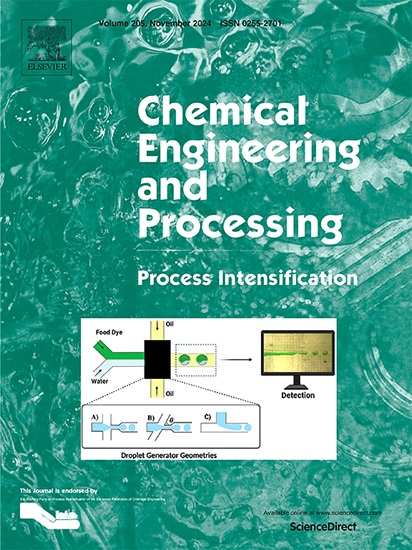The interaction between microwave and vanadium-bearing shale: A study on the microwave-assisted leaching mechanism of vanadium
IF 3.8
3区 工程技术
Q3 ENERGY & FUELS
Chemical Engineering and Processing - Process Intensification
Pub Date : 2025-02-08
DOI:10.1016/j.cep.2025.110213
引用次数: 0
Abstract
Microwave heating technology has received considerable attention for vanadium-bearing shale (VBS) leaching. In this paper, a multi-physics model was established to investigate the electromagnetic response of VBS. Simultaneously, microwave enhanced leaching mechanism was revealed from the perspective of VBS thermal response. The simulation results indicated that the heating time of microwave heating is only 1/18 of that of conventional heating. VBS particles during the leaching process generate high-temperature hotspots (235–261 °C) much higher than the leaching environment (100 °C) due to electric field polarization. Higher temperature leads to faster chemical reaction rate, which affects the diffusion efficiency of products outside the sample over time. The VBS leaching process is mainly controlled by two stages: Microwave energy can reduce the activation energy of the stage Ⅰ from 41.57 kJ/mol to 21.28 kJ/mol and the activation energy of the stage Ⅱ from 59.61 kJ/mol to 43.65 kJ/mol. After microwave irradiation, the surface energy of VBS will increase, and the energy of the leaching system will also be higher, accelerating the erosion and damage of H+ on muscovite. Meanwhile, the hydration and hardening phenomenon of gypsum induced by hot spots causes gypsum to transform into hard gypsum on the surface of mica. The growth stress generated during the growth process of hard gypsum will damage the structure of muscovite. The microwave-assisted leaching mechanism of VBS can give more guidance for microwave application.

微波与含钒页岩的相互作用:钒的微波辅助浸出机理研究
微波加热技术在含钒页岩浸出中的应用备受关注。本文建立了一个多物理场模型来研究VBS的电磁响应。同时,从VBS热响应的角度揭示了微波增强浸出机理。仿真结果表明,微波加热的加热时间仅为传统加热的1/18。浸出过程中,由于电场极化,VBS颗粒产生了远高于浸出环境(100℃)的高温热点(235 ~ 261℃)。温度越高,化学反应速度越快,随着时间的推移会影响产物在样品外的扩散效率。VBS浸出过程主要受两个阶段控制,微波能使Ⅰ阶段的活化能从41.57 kJ/mol降低到21.28 kJ/mol,Ⅱ阶段的活化能从59.61 kJ/mol降低到43.65 kJ/mol。微波辐照后,VBS的表面能增加,浸出体系的能量也随之提高,加速了H+对白云母的侵蚀和破坏。同时,热点引起的石膏水化硬化现象使石膏在云母表面转变为硬石膏。硬石膏生长过程中产生的生长应力会破坏白云母的结构。VBS的微波辅助浸出机理可以为微波应用提供更多的指导。
本文章由计算机程序翻译,如有差异,请以英文原文为准。
求助全文
约1分钟内获得全文
求助全文
来源期刊
CiteScore
7.80
自引率
9.30%
发文量
408
审稿时长
49 days
期刊介绍:
Chemical Engineering and Processing: Process Intensification is intended for practicing researchers in industry and academia, working in the field of Process Engineering and related to the subject of Process Intensification.Articles published in the Journal demonstrate how novel discoveries, developments and theories in the field of Process Engineering and in particular Process Intensification may be used for analysis and design of innovative equipment and processing methods with substantially improved sustainability, efficiency and environmental performance.

 求助内容:
求助内容: 应助结果提醒方式:
应助结果提醒方式:


